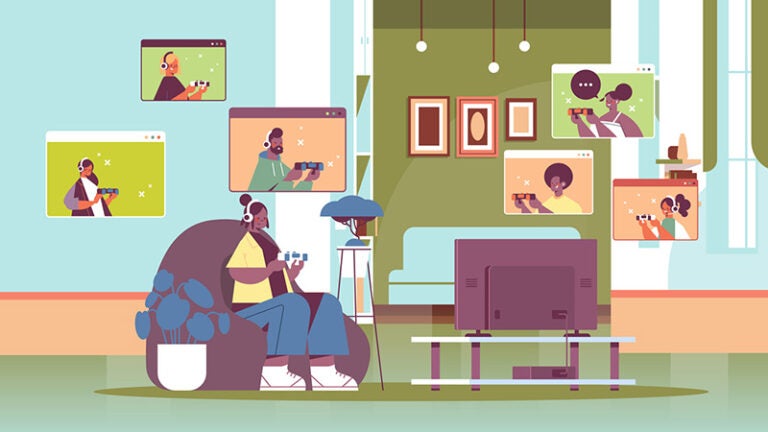
Video games have the power to bring people together, says USC’s Gordon Bellamy (Photo/iStock)
The Future of Video Games: More Interactive, More Global — and More Streaming?
A gaming industry pioneer talks about how far games have come and how streaming is leveling up interactive experiences.
Texting is as natural to many of us as talking — especially among the younger crowd. But Gordon Bellamy still remembers when he first heard about it. “Back in the day, I thought, ‘This will never work. Who wants to press ABC buttons like an old typewriter?’” (Yes, kids, texting once required a keypad mounted to your phone.)

But then he saw how texting enabled people to interact with others in a meaningful way. “Seeing how it gave agency — that was a transformative interaction for me,” he says.
Bellamy, a USC professor of the practice of cinematic arts, has long been fascinated by how gaming technology keeps us connected and creates new communities. Growing up, he was obsessed with video games and dreamed of working at Electronic Arts, the company behind his favorite titles like Madden NFL and NHL, a hockey game. Cold-calling the company from his Harvard dorm room landed him an entry-level job. Later, as a designer, he pushed for Black representation in Madden NFL ’95, which became the first game in the series to feature diverse players. It was also the first sports game to have Black players on the product packaging.
Gordon Bellamy, who successfully pushed for Black representation in Madden ’95, champions for LGBTQ+ inclusivity and diversity in the industry.
As the game industry evolved and grew — it’s a global market with a projected 2021 revenue of more than $138 billion — so did Bellamy. He moved through roles at companies from Tencent to MTV and got noticed in the process, picking up honors such as Games for Change’s Vanguard Award for championing LGBTQ+ representation in games. Now, the video game industry veteran teaches undergraduate courses in USC School of Cinematic Arts’ Interactive Media & Games Division, part of USC Games, the top-ranked game design program in the country. He shares his thoughts on how the gaming world has changed, its power to build community and the possibilities ahead.
We’ve hit many major milestones in the gaming world in recent decades. What standout games first blew your mind?
Ultima IV, where you got to choose your character. [The Apple II game was released in 1985.] You’d do this interview and answer questions, which informed who your character was. That was a mind-blowing moment for games on agency, on your ability to impact the outcome of a game. Rather than just being digitized, it was very humanizing. It was a huge moment.
Farmville created the new verb of getting people to do something for you asymmetrically. [The game launched on Facebook in 2009.] The idea of, “Oh, hey, come on my page and water my potatoes.” That didn’t exist before! We’re going to create this new dynamic between us where you are going to be serving my game while I’m away and I’m going to benefit from that. That was mind-blowing.
Street Fighter changed what a joystick was. [The arcade game was first released in 1987.] Until then, a joystick was used to steer my character. After Street Fighter, I was like, “What? Joysticks are for moving things around like this?! You can control all different characters as long as you understand how to manipulate the joystick?” The game made joysticks something where you could think about what your movements were and take actions.
As a leader in the gaming industry, how do you teach students who will be the next generation of game designers?
USC School of Cinematic Arts’ Interactive Media & Games Division is part of USC Games, the top-ranked game design program in the country.
Games are a global phenomenon. Games are a language that is shared everywhere in the world. Here at USC, we have the privilege of amplifying that. Sort of metaphorically, our role as professors is putting stakes in the ground for a plant to grow. I feel like the faculty and the staff are like those stakes, right? We offer a curricular structure and extracurricular opportunities [for students] to grow toward the sun. And when they grow — these incredible voices — it’s fascinating.
Right now, I’m teaching two courses. One is “Anatomy of the Game,” which teaches games as canon, much in the way you think of television or film appreciation. It’s about game appreciation and discourse, and we bring in top designers, creators and executives for fireside chats, and then the students synthesize what we’re talking about. I’m also doing “Introduction to Streaming.” It’s about the YouTube, Facebook, Twitch, Instagram and TikTok ecosystem. It’s about empowering our next generation of not only creators but also people who want to work in and around this craft. It’s like cinema, where film courses cover everything from concept creation to production to acting to distribution and experience. This new craft of live creation content is the next thing. There’s now live creation of content, which if you look forward five, 10 years, it’s going to be native.
Tell us more about live creation and how you think streaming will evolve.
Bellamy predicts gaming — an industry with a projected 2021 revenue of $138 billion — will offer increasingly interactive and immersive experiences.
So, going back to streaming — that’s live communication, that’s unedited content, right? And I think there will be unedited content, which is performative, like there is now. I think there’ll be unedited play, and I know this sounds — well, just leap forward with me for a second and imagine games right now. If you go into a multiplayer online game, like World of Warcraft, a lot of the play is actually emergent to the people who are playing it. Say there is going to be a [big, planned activity in the game], like they’re going to release a new dragon on a certain day. And that sort of sets the cadence at which players are able to create their game experiences.
I think that’s going to get faster and perhaps even be interactive. I’m on a board of a company called Wave XR that does virtual entertainment. We do live shows for John Legend and The Weeknd. And what’s super exciting and why it’s different is the crowd doesn’t just sit and watch. In addition to chatting and emoting, they’re actually helping drive the show. They’re making decisions collectively that change the world that they and the artist are all experiencing. So, each show is different and one of a kind because of what people decided and what they built as part of the show experience.
That’s a little bit like streaming. Like on Twitch, the agency that people have with content is getting faster and faster and more and more impactful. People will be able to fluidly move between leaning back, where I’m watching an experience that is served to me, and leaning in, where I’m actually impacting how it serves me and others around me.
Games are sometimes criticized as isolating because they disconnect people from the real world. How would you argue that games bring people together?
Games are a shared experience that we can impact, which is different than a shared experience that we both view. Having that commonality is really meaningful. It is native to the generation of young people coming up.
It’s humanizing. If you are not told who people are but you actually experience them through play, then your views will be shaped by your experiences as much they are shaped extrinsically by what the media tells you about someone.
There’s a lot going on right now with people who feel they are so different than each other, who say, “We have nothing in common.” How about games? Tonight, right now, people are playing together in a game. They don’t know each other, but they’re getting along fine. Because of shared goals, they’re accomplishing big things left and right — killing dragons, going on missions. And it’s because all those biases are stripped away for a second. So, you might find yourself in great conflict with people who are on the street or on a blog. “Oh my god, we are not aligned in our values!” But here we are playing.
And conversely, and I think more broadly, as a point of discovery, there are so many opportunities for people to grow and find commonality — beyond what someone is or even who they are, to the shared experiences that actually occurred. No one will be able to say that you didn’t kill the game’s dragon together, because you did.
Editor’s note: This interview has been lightly edited for clarity and brevity.



